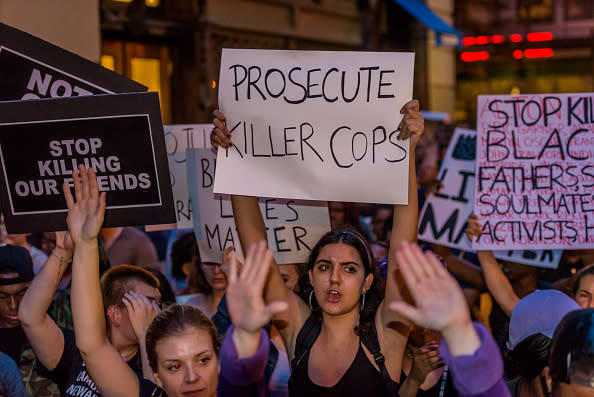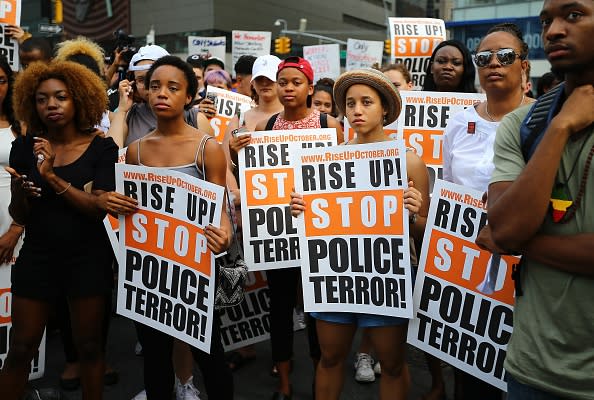
Conventional wisdom dictates that if you’re caught on camera committing a crime, your conviction will soon follow. It’s how convenience store thieves are thwarted, how assailants in elevators and hotel lobbies are identified, and how robberies at ATMs end with criminals punished for their misdeeds.
But conventional wisdom, it seems, does not extend to police officers caught on tape assaulting and killing civilians—particularly, as in the cases of Eric Garner and Walter Scott and many others, when those civilians are black men. Two more harrowing video clips from the last few weeks are still circulating online. One depicts the shooting death of Alton Sterling in Baton Rouge, Louisiana; another shows the aftermath of the shooting of Philando Castile in his car following a routine traffic stop in Falcon Heights, Minnesota. After the U.S. Supreme Court set a dangerous precedent by ruling that illegally-obtained evidence can be used in some cases, the calls for accountability of police brutality have never been louder or more helpless. It's utterly perplexing: How can video footage showing fatal police brutality not result in conviction?
The answer is both more straightforward and more confounding than it may seem. Whether or not an officer is convicted depends solely on one question: From a legal perspective, is it reasonable to surmise that the police officer in question felt that his life was in danger?
From a non-legal perspective, officers can argue that anything made them feel threatened, since there's no way their perception might be refuted. As for proving or disproving this perception of danger, video captured at the scene is only valuable if it contains enough information to sway a judge or jury one way or the other.
How can video footage showing fatal police brutality not result in conviction?
How does a police officer go about proving that murder was justified? Well, first, they re-frame their distance with rhetoric and make sure not to call it "murder."
“You’re rarely going to have the case of a police officer intending to go out and murder someone,” explains Jason Trager, an Assistant District Attorney in New York. “So, when you say that somebody was murdered [in a case like Sterling’s or Castile’s], you’re actually legally incorrect. There was a homicide, but a murder would mean that an officer intended to go out and kill you. That’s rarely what happens when a police officer is on duty, speaking from a legal perspective.”

In court, intent is the key differentiator. Take, for example, Philando Castile’s case. Diamond Reynolds, Castile’s girlfriend, began livestreaming a video to Facebook immediately after Castile was shot. In the clip, Reynolds says that the pair was initially pulled over for a broken tail light. Legally, “you can almost remove intent from what the officer is doing, because she’s basically admitting there was a reason to pull her over,” Trager says. “An officer is supposed to pull you over with a broken tail light.”
So, if the court agrees that the officer is cleared in terms of intent, based on video footage and, presumably, the officer’s own testimony, it’s then classified as homicide, and the question becomes whether it was “justifiable” or “reckless.” To determine that, a judge or jury would then seek information about what happened leading up to the incident—a series of events that were not caught on camera during the Castile incident.
“If you look at this Falcon Heights video, the first thing to realize is that this is not a video of the event,” Trager says. “Whatever has happened has already occurred by the time this video is started. The shooting is done. All you’re getting is recorded witness testimony. The substance of what she’s saying is no different than if she testified.”
In the absence of video footage, Reynolds’ narration on the recording provides details that can lend credibility to her version of how the incident occurred, especially if her testimony in court and her claims on film remain consistent. But, in a perverse twist, those details could actually stand to help the police officer prove his actions were justified from a legal perspective.
Reynolds says on camera that Castile told the police officer he has a license to carry a gun and had one on his person. She also says he reached for his license and registration in his pocket. “So now,” says Trager, “go back to the officer’s mindset: ‘I have a reason to pull these people over. I’m probably going to write them a ticket. I don’t know who these people are. I’m kind of exposed. I’m confronting them, and now I know that this person has a firearm. He’s reaching somewhere I can’t see, and he puts his hands forward.’ And that’s when he has to make his decision.” That, in the eyes of a judge and jury, is feasibly enough to prove the officer believed his life was legitimately threatened; thus, Castile’s shooting could be ruled “justifiable homicide.”

But, even if Reynolds didn’t have the superhuman wherewithal to begin filming early enough to capture the entire incident on video, Sterling’s death was caught on film. Taken together, two videos that have emerged from the scene of Sterling’s death offer a much more complete account of what happened there, compared to video of the Castile incident. Sterling’s encounter with police is captured on film starting when the police approach him and continuing after their weapons were fired. Even with that amount of footage, a conviction is far from a sure thing. Edward Carrasco, a retired police officer with 22 years of experience with the NYPD, explains how this could imaginably pan out in court.
First, intent: The police officers were called to the scene, Carrasco points out. They didn’t seek out Sterling on their own. “The jury or judge would have to know that fact,” he says. “It would take away the intent, almost.”
If you’re trying to cuff somebody, and they don’t want to be cuffed, and they have a gun, and the guy’s going for it—as somebody who served 22 years in law enforcement and never fired his weapon, I can’t say that I would not have fired my weapon.
Next, was the homicide justifiable? Carrasco explains, “If you’re trying to cuff somebody, and they don’t want to be cuffed, and they have a gun, and the guy’s going for it—as somebody who served 22 years in law enforcement and never fired his weapon, I can’t say that I would not have fired my weapon. I’m not making a judgment whether it was justified or not, but this is something that will have to be examined.” He adds that understanding how police knew Sterling had a weapon is pivotal to explaining how threatened they could conceivably feel—information that can’t be ascertained from the existing video clips alone.
It could potentially be that simple. For advocates of police reform, the solution most frequently offered as a way to answer more of these questions definitively—body cameras for officers—could, in theory, work. Carrasco is a proponent of body cams, but cautions they would need to be operated flawlessly to provide a full picture of the course of events. “It has to be continuously rolling, as far as I’m concerned, because I want to see everything,” he says. “I don’t want to see 10 seconds of a three minute altercation. You shouldn’t begin to tape when a confrontation begins to escalate. Before you get out of the car, before you utter the first words, it should already be on and capturing.”
Unless we want to live in a world where every citizen is strapped with a body cam that's constantly rolling, the recording onus lies entirely with the police; there is no reasonable recourse for civilians looking to ensure that their entire interaction with law enforcement is caught on tape.
And therein lies the problem. Unless we want to live in a world where every citizen is strapped with a body cam that's constantly rolling, the recording onus lies entirely with the police; there is no reasonable recourse for civilians looking to ensure that their entire interaction with law enforcement is caught on tape. That sentiment is echoed throughout the entire system as it exists today. If video doesn't capture a complete timeline of events, starting before escalation, it favors police. The political semantics that classify a killing as murder vs homicide also favor police, as does the likelihood that an entire jury would agree that there is absolutely zero chance a police officer could have reasonably feared for his life. Police, by nature of their jobs, put themselves in situations that ordinary civilians would usually avoid, precisely because they're dangerous. What judge or jury can argue with that?
Investigations are pending in the deaths of both Sterling and Castile, and the video footage, racking up play counts well into the millions, will undoubtedly stoke more outrage, confusion, and feelings of powerlessness within the general public, especially within the African American community. And they should. What would it say about us as a people if witnessing someone breathing their last breath doesn't cause a deep, visceral reaction?
The events depicted in the videos, however, are final. There is no discussion of the outcome; Philando Castile, Alton Sterling, Eric Garner, Walter Scott, and so many others before them are gone forever. In the court of public opinion, video footage of their last moments is sufficient to convict and sentence these police officers. In the court of law, though, all signs seem to indicate that video is simply not enough to engender the same results. It wouldn't be the first time conventional wisdom was just plain wrong.

